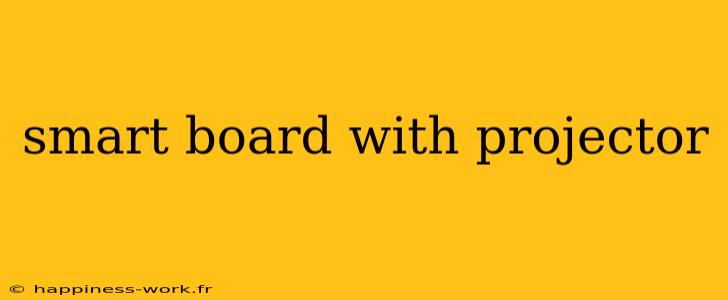In recent years, the integration of technology in educational settings has transformed the teaching and learning experience. Among these innovations, the smart board with projector has emerged as a powerful tool for educators and students alike. This article explores the features, benefits, and best practices for utilizing a smart board with a projector, providing insights into its impact on modern classrooms.
What is a Smart Board with Projector?
A smart board is an interactive whiteboard that allows users to control a computer using a touch-sensitive screen. When paired with a projector, it enhances the visual aspect of presentations and lessons, making it easier to convey information effectively.
Key Features of a Smart Board with Projector
- Interactive Touchscreen: Users can write, draw, and interact with content directly on the board, making lessons more engaging.
- Multimedia Support: The ability to integrate videos, images, and audio enhances presentations.
- Collaboration Tools: Multiple users can interact with the board simultaneously, fostering collaborative learning.
- Compatibility with Educational Software: Many smart boards are designed to work seamlessly with various educational applications and tools.
Benefits of Using a Smart Board with Projector
-
Enhanced Engagement: The interactivity of a smart board captures students' attention and keeps them engaged. When learners actively participate in lessons, retention improves.
-
Flexibility in Teaching: Educators can switch between different media formats, from digital presentations to videos, allowing for a more dynamic learning experience.
-
Real-Time Feedback: Teachers can easily gauge student understanding through interactive quizzes and polls.
-
Accessibility: Content can be adapted for diverse learning needs, helping to ensure that all students can participate in lessons.
-
Collaboration and Group Work: Smart boards facilitate group projects by allowing multiple students to contribute to the same workspace.
How to Use a Smart Board with Projector Effectively
1. Plan Your Lessons
Prepare your lessons in advance, considering the tools and resources available on the smart board. Incorporating interactive elements such as quizzes or polls can promote engagement.
2. Utilize Educational Software
Take advantage of educational software that works well with smart boards. Programs such as Google Classroom and Kahoot! can enhance interactivity.
3. Incorporate Multimedia
Use videos, animations, and images to illustrate key concepts. This caters to various learning styles and keeps students' interest piqued.
4. Encourage Student Participation
Invite students to come up to the board to solve problems, contribute ideas, or discuss concepts. This builds confidence and improves communication skills.
5. Provide Clear Instructions
Make sure students understand how to use the smart board's features. Spend time teaching them how to navigate tools so they feel comfortable using them.
6. Gather Feedback
At the end of a lesson, solicit feedback from students regarding what they found helpful or challenging. Use this information to improve future lessons.
SEO Optimization Tips
To ensure this article reaches its intended audience, we’ve incorporated relevant keywords such as "smart board," "interactive learning," "classroom technology," and "educational tools." Additionally, structuring the content using headers and bullet points helps with readability and engagement.
Example Use Case
Consider a high school biology teacher who uses a smart board with a projector during a lesson on cellular biology. By displaying 3D models of cells, incorporating videos explaining cellular processes, and inviting students to illustrate parts of the cell on the board, the teacher creates a comprehensive and engaging learning experience.
Conclusion
The smart board with projector represents a significant advancement in educational technology, fostering a collaborative and interactive environment. As educators continue to adapt to this new digital landscape, understanding how to utilize these tools effectively is essential for enhancing the learning experience.
For more detailed instructions on using smart boards, be sure to check out the original contributors on WikiHow for valuable insights and tips. By combining these foundational techniques with the additional strategies mentioned above, educators can harness the full potential of smart boards to inspire and educate students effectively.
By exploring these angles, we not only provide basic information on smart boards but also delve into practical applications and effective teaching strategies, which adds value for both educators and students interested in enhancing their learning environments.
